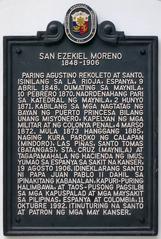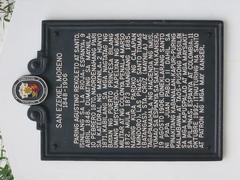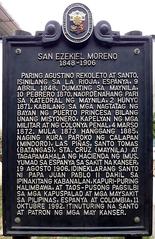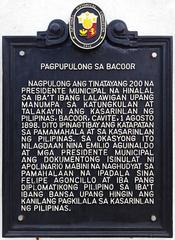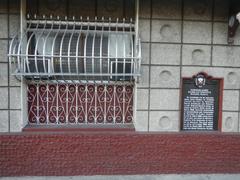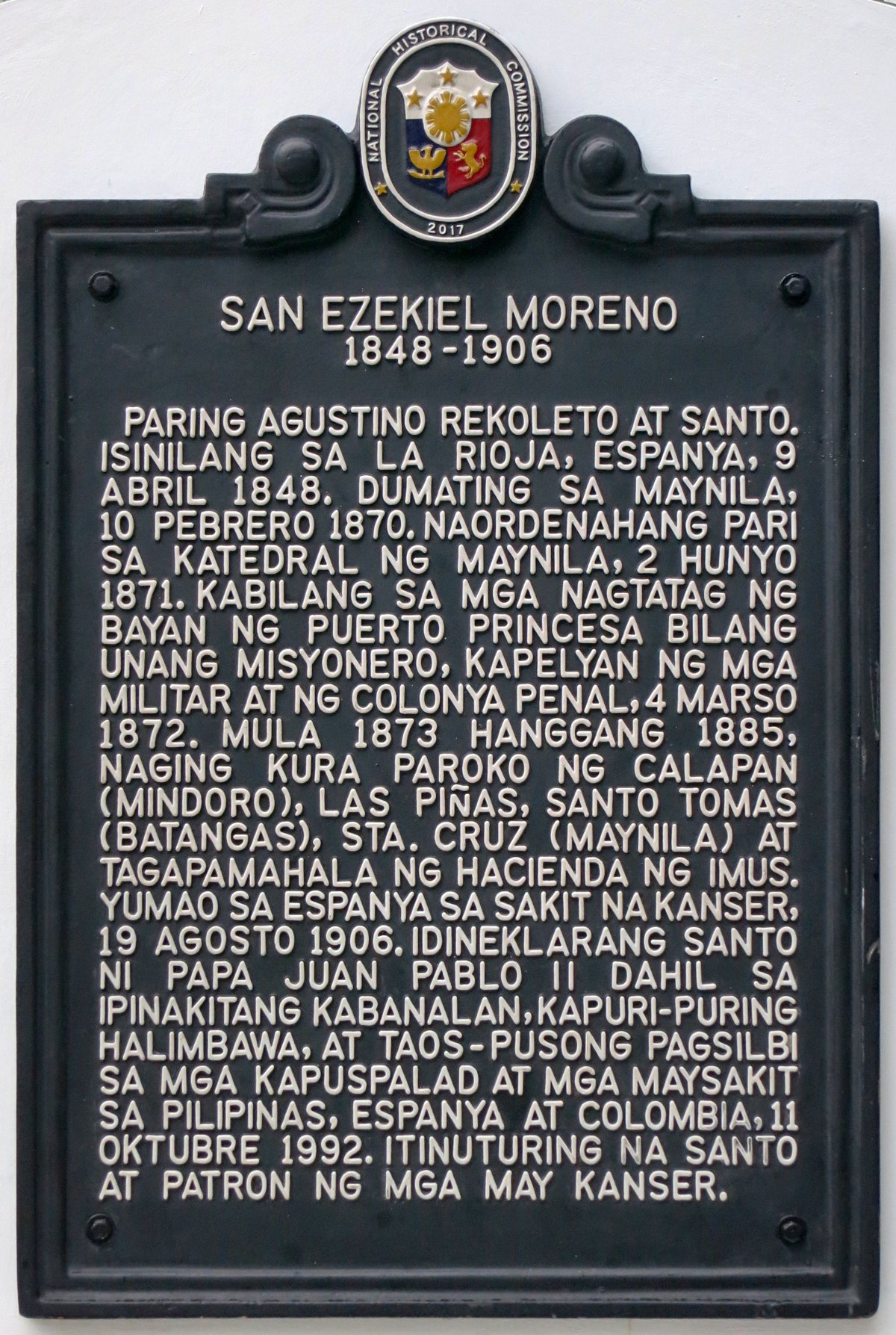
Saint Ezequiel Moreno Historical Marker Bacoor: Visiting Hours, Tickets, and Travel Guide
Date: 14/06/2025
Introduction
Situated in Bacoor, Cavite, the Saint Ezequiel Moreno Historical Marker and Park stands as a tribute to one of the Philippines’ most revered missionary saints. Saint Ezequiel Moreno y Díaz—a Spanish Augustinian Recollect who arrived in the Philippines in 1870—distinguished himself through his compassionate ministry, especially during epidemics and in community development projects like the maintenance of the Molino Dam. Canonized in 1992 by Pope John Paul II, Saint Ezequiel is also honored as the patron saint of cancer patients. This comprehensive guide provides all the essential information for visiting the site: hours, ticketing, accessibility, guided tours, nearby attractions, and practical travel tips. Whether you are a history buff, pilgrim, or traveler eager to explore Philippine heritage, this landmark is a must-visit that connects faith, history, and community spirit (Bacoor City Government; National Historical Commission of the Philippines; Senate of the Philippines).
Table of Contents
- Historical Background of Saint Ezequiel Moreno
- Visiting the Saint Ezequiel Moreno Historical Marker and Park
- Significance of the Marker
- Nearby Attractions and Experiences in Bacoor
- Tips for a Meaningful Visit
- Frequently Asked Questions (FAQ)
- Visual Gallery
- Preservation and Continuing Relevance
- Plan Your Visit Today
- References
Historical Background of Saint Ezequiel Moreno
Saint Ezequiel Moreno y Díaz (1848–1906) was born in Alfaro, La Rioja, Spain, and joined the Augustinian Recollect Order in 1864, inspired by his brother (Agustinos Recoletos). Arriving in the Philippines in 1870, Moreno served in several Luzon parishes, including Bacoor and Las Piñas. He gained deep local respect for his tireless ministry during a cholera epidemic in Bacoor, where he administered sacraments to thousands of victims (Bacoor City Government). His leadership extended beyond the pulpit, spearheading community projects like the repair and maintenance of the Molino Dam—a critical infrastructure for local agriculture (Senate of the Philippines).
After his Philippine mission, Moreno became Bishop of Pasto in Colombia, where he continued his humanitarian work until his death in 1906. He was canonized in 1992, further cementing his legacy as a spiritual leader and the patron saint of cancer patients (Pintakasi PH).
Visiting the Saint Ezequiel Moreno Historical Marker and Park
Location and Directions
The marker and park are located within Barangay Mambog, Bacoor City, Cavite, near the historic Molino Dam. From Manila, visitors can take the Cavite Expressway (CAVITEX) and exit at Bacoor. The site is accessible via public jeepneys, buses, or taxis. For those driving, parking is available near the park, though spaces may be limited during special events.
Visiting Hours and Tickets
- Hours: Open daily, typically from 6:00 AM to 8:00 PM
- Admission: Free of charge; no tickets required
Visitors are encouraged to check the Bacoor City Tourism Office website or local announcements for any temporary changes in hours, especially during holidays or events.
Accessibility
The park features paved walkways, ramps, and shaded seating areas, making it accessible for wheelchairs, strollers, and elderly visitors. Restrooms and security personnel are present, though availability of some amenities may vary.
Guided Tours and Visitor Experience
Guided tours can be arranged through the Bacoor City Tourism Office for a more in-depth exploration of the site and its history. Self-guided tours are also welcomed, with informational panels available in both Filipino and English. The park offers several photographic spots, including the monument, garden, and nearby dam.
Significance of the Marker
The Saint Ezequiel Moreno Historical Marker is a formal recognition by the National Historical Commission of the Philippines, commemorating Moreno’s influence on Bacoor and the broader Cavite region. The marker is a cast-iron plaque installed near the Molino Dam, accompanied by a statue of the saint (Senate of the Philippines). It honors Moreno’s humanitarian leadership—his efforts during epidemics, and his role in community infrastructure like the dam, which was essential for agriculture and local development.
The marker also symbolizes the interconnected histories of Bacoor and Las Piñas, as the Molino Dam served both communities. Today, the site serves as both a spiritual pilgrimage destination and a community heritage landmark, especially meaningful for those seeking the intercession of the patron saint of cancer patients.
Nearby Attractions and Experiences in Bacoor
Enhance your visit by exploring other notable Bacoor historical sites:
- St. Michael the Archangel Parish Church: The city’s oldest church, dating back to 1669, and a focal point of local religious life.
- Bahay Tisa (Cuenca Ancestral House): A well-preserved Spanish-era residence.
- Zapote Bridge: Historic site of the Battle of Zapote Bridge during the Philippine Revolution.
- Bamboo Organ Church (Las Piñas): Renowned for its unique bamboo pipe organ.
- Immaculate Conception Cathedral (Puerto Princesa): Related to Moreno’s ministry.
Nearby, you can sample Bacoor’s culinary specialties, such as Digman Halo-Halo and kakanin (rice cakes), or visit the vibrant public market.
Tips for a Meaningful Visit
- Combine your visit with a heritage walk through Bacoor’s historical sites.
- Attend Mass or local church events to experience the community’s faith traditions.
- Dress modestly and comfortably, respecting the site’s religious nature and the tropical climate.
- Bring water and sun protection, especially during the dry season.
- Check event schedules if you wish to attend special commemorations, such as the feast day of Saint Ezequiel Moreno on August 19.
Frequently Asked Questions (FAQ)
Q: What are the visiting hours for the Saint Ezequiel Moreno Historical Marker and Park?
A: The park is open daily from 6:00 AM to 8:00 PM.
Q: Is there an entrance fee or tickets required?
A: No, admission is free.
Q: Is the site wheelchair accessible?
A: Yes, the park has paved paths and ramps suitable for wheelchairs and strollers.
Q: Are guided tours available?
A: Guided tours can be arranged through the Bacoor City Tourism Office.
Q: How do I get to the park using public transport?
A: Take buses or jeepneys bound for Cavite, alight near Bacoor city center, then use a tricycle or local jeepney to reach the park.
Visual Gallery
 Alt text: Saint Ezequiel Moreno Historical Marker, Bacoor City
Alt text: Saint Ezequiel Moreno Historical Marker, Bacoor City
Alt text: Saint Ezequiel Moreno Park with visitors and gardens
 Alt text: Statue of Saint Ezequiel Moreno near the historical marker
Alt text: Statue of Saint Ezequiel Moreno near the historical marker
Preservation and Continuing Relevance
The Saint Ezequiel Moreno Historical Marker is maintained by the National Historical Commission of the Philippines, with support from the Bacoor local government (Senate of the Philippines). Regular educational programs, festivals, and heritage initiatives ensure the marker remains an active part of Bacoor’s identity and collective memory. The site serves as both a pilgrimage destination—thanks to Saint Ezequiel’s status as a patron of cancer patients—and an educational resource for local and foreign visitors.
Plan Your Visit Today
Experience the intersection of faith, history, and community at the Saint Ezequiel Moreno Historical Marker and Park. Download the Audiala app for guided heritage tours, follow Bacoor’s official tourism channels for updates, and explore more of the city’s rich cultural sites. Whether for quiet reflection or an immersive learning journey, your visit will deepen your appreciation for Bacoor and the enduring legacy of Saint Ezequiel Moreno.
References
- Bacoor City Government
- National Historical Commission of the Philippines
- Senate of the Philippines
- Bacoor City Tourism Office
- Agustinos Recoletos
- Pintakasi PH
- Trip the Islands
- Recoletos.ph
